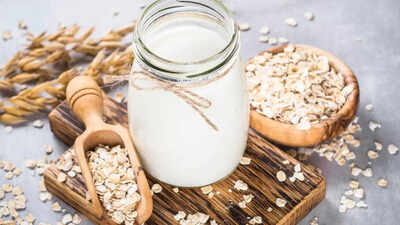ARTICLE AD BOX

Oat milk has become a go-to dairy alternative for health-conscious individuals, offering a creamy taste and being naturally free from lactose, nuts, and soy. It’s often praised for its fibre content, added calcium, and eco-friendly profile, making it seem like the perfect everyday choice.
However, drinking oat milk daily may not suit everyone. Regular consumption can bring potential downsides, from hidden sugars and high carbohydrate content to bloating, allergies, or nutrient imbalances. Understanding these risks is important before making oat milk your primary beverage. Here are seven health drawbacks you should know about daily drinking oat milk.
7 Side effects of drinking oat milk every day
Bloating and indigestion
Oats are a natural source of fiber and prebiotics, which usually benefit gut health.
However, for people who are sensitive to fiber or have certain digestive conditions, drinking oat milk may cause bloating, gas, or stomach discomfort.Those with celiac disease or gluten sensitivity may also react to avenin, a protein found in oats that resembles gluten. Even certified gluten-free oat milk could trigger symptoms for some people. On top of this, many brands use emulsifiers to keep oat milk smooth and shelf-stable.
Early research suggests that certain emulsifiers may disturb gut bacteria balance, leading to digestive discomfort, though more studies are needed.
Extra sugar intake
Not all oat milk is created equal. While plain, unsweetened varieties are relatively healthy, many commercial brands add sugar to improve flavor. Excess sugar consumption is linked to weight gain, tooth decay, insulin resistance, type 2 diabetes, and cardiovascular problems.According to the American Heart Association, women should limit added sugars to 25 grams per day, while men should stay under 36 grams. Some flavored oat milks can contain 7–15 grams of sugar per serving—nearly half of the daily allowance. Reading labels and choosing unsweetened or lightly sweetened versions is essential to keep sugar intake in check.
Allergic reactions
Although oat allergies are less common than allergies to milk, soy, or nuts, they do occur. People who are allergic to oats may develop skin irritation, itching, hives, or digestive upset after consuming oat milk.
In rare cases, an oat allergy could trigger anaphylaxis, a life-threatening reaction that requires immediate medical attention.It’s not just the oats themselves that can cause problems. Some oat milk brands include additives such as xanthan gum or guar gum, which may trigger digestive issues in sensitive individuals. If you notice unusual symptoms after drinking oat milk, check ingredient labels carefully and consider consulting an allergist.
High carbohydrate load
Oat milk is higher in carbohydrates than cow’s milk or some nut-based alternatives. While these carbs are mostly complex and provide steady energy, they can still add up quickly for people managing their blood sugar or following lower-carb diets.The glycemic index (GI) of oat milk ranges between 49 and 69, and its glycemic load (GL) falls between 12 and 17—both considered moderate. This means oat milk can raise blood glucose more than cow’s milk, which has a much lower GI and GL.
For people with diabetes or those watching their carb intake, drinking oat milk every day may make it harder to maintain stable energy and blood sugar levels.
Risk of gluten or soy contamination
Pure oats are naturally gluten-free, but cross-contamination during processing is common. Oat milk produced in facilities that handle wheat, barley, or rye may contain trace amounts of gluten. This can be dangerous for individuals with celiac disease or severe gluten intolerance.Similarly, some oat milks are processed in plants that also handle soy products, creating a risk of soy contamination. For people with allergies or sensitivities, it’s best to choose oat milk that is clearly labeled “certified gluten-free” and check for allergen statements on the packaging.
Impact of added ingredients
While homemade oat milk is usually just oats and water, store-bought versions often contain oils, stabilizers, salt, and preservatives to improve taste and shelf life.
While these are generally recognized as safe, they may not be ideal for everyone.For example, some brands use dipotassium phosphate as a stabilizer. This additive can be problematic for people with kidney disease, potentially worsening kidney function or affecting heart and bone health. If you are on a restricted diet or managing a health condition, reading ingredient labels is especially important.
Nutrient imbalance in babies and young children
Oat milk is not suitable as a replacement for breast milk or infant formula.
It lacks the protein, fat, and micronutrients that babies under 12 months require for healthy growth and development. Even in toddlers, oat milk should not replace cow’s milk entirely unless recommended by a healthcare provider.While fortified oat milk can be a safe option for older children and adults, it should be offered alongside a balanced diet. Parents considering oat milk for their children should check labels for added sugars and consult with a pediatrician to ensure proper nutrition.
How much oat milk is safe to drink?
For most adults, moderate consumption of oat milk is perfectly healthy, especially if you choose unsweetened, fortified brands. Oat milk provides fiber, B vitamins, and minerals and is naturally low in saturated fat. However, it should not be your only source of nutrients, nor should it replace protein-rich foods like dairy, soy, or legumes.A cup or two of oat milk per day can fit into a balanced diet, but drinking large amounts, especially of sweetened varieties, may cause health issues over time.
Listening to your body, watching portion sizes, and checking labels are the best ways to enjoy oat milk responsibly.Oat milk is a healthy alternative for many people, but daily consumption can lead to bloating, sugar overload, carb spikes, or nutrient gaps depending on your health needs. Choose your brand wisely, balance it with other protein-rich foods, and pay attention to how your body responds.Also Read: Best and worst foods for gout: Reduce inflammation and protect joints naturally



.png)
.png)
.png)
















 4 hours ago
3
4 hours ago
3









 English (US) ·
English (US) ·